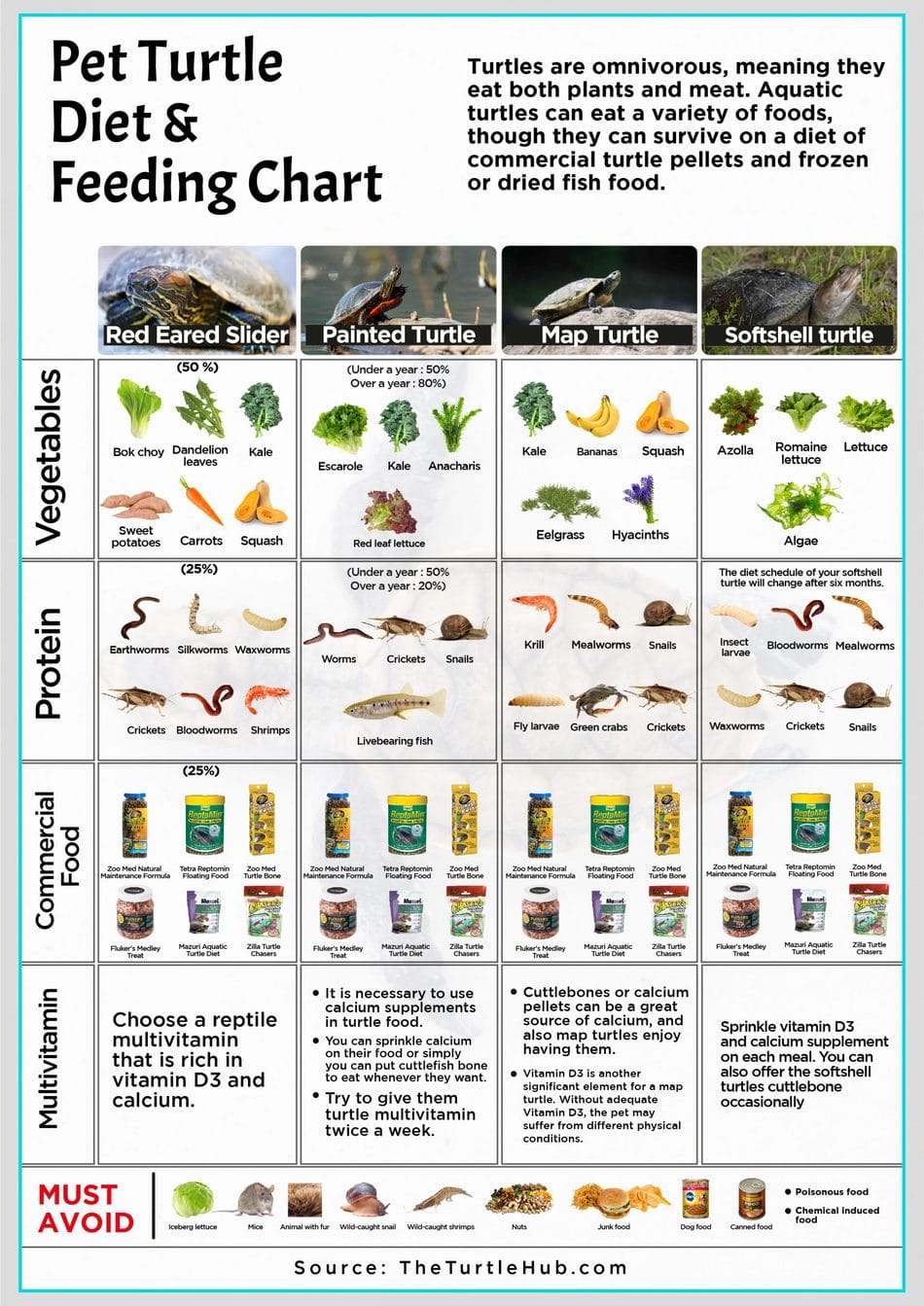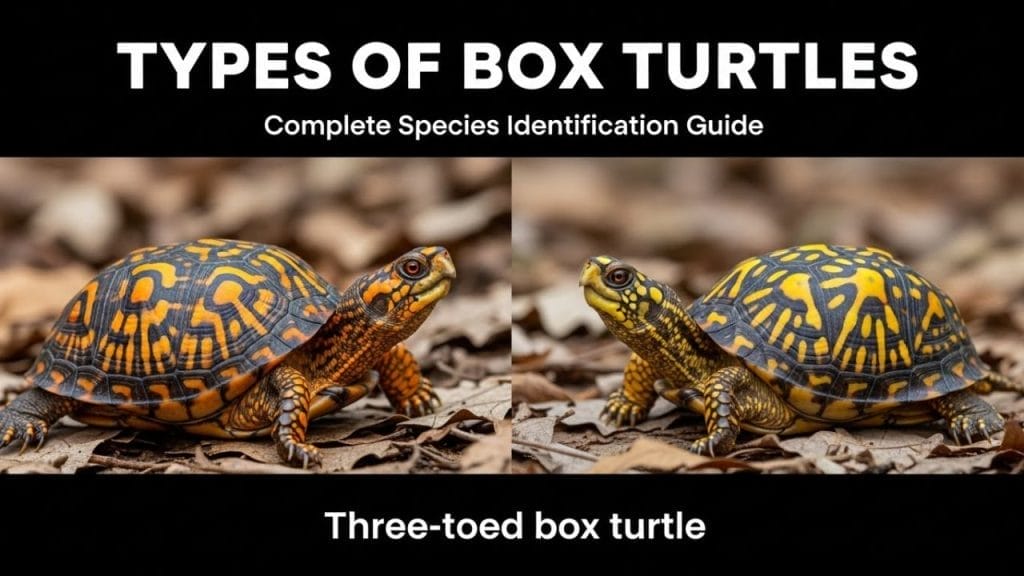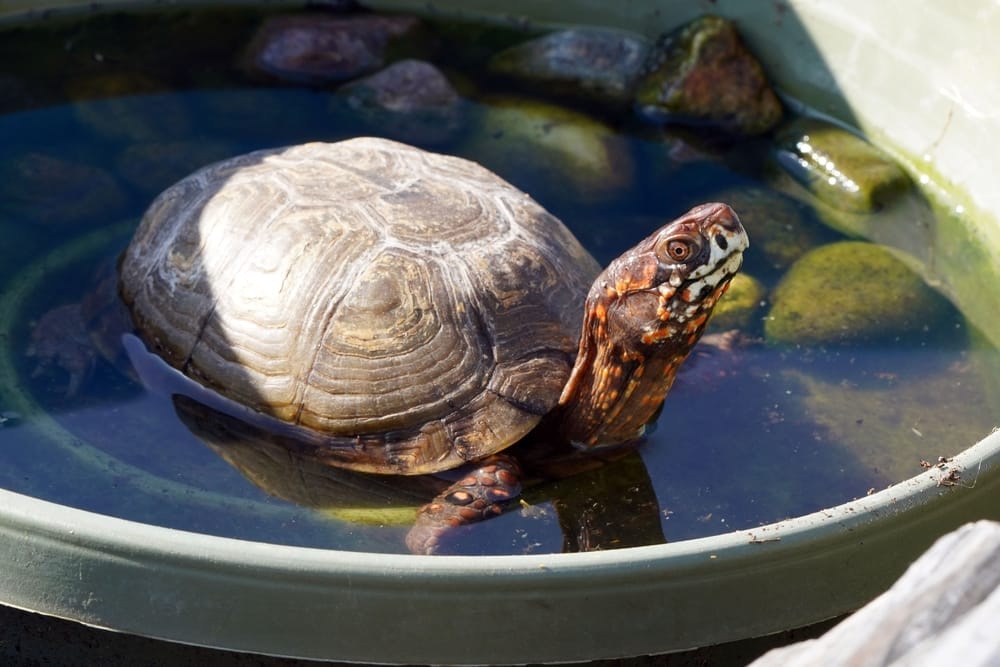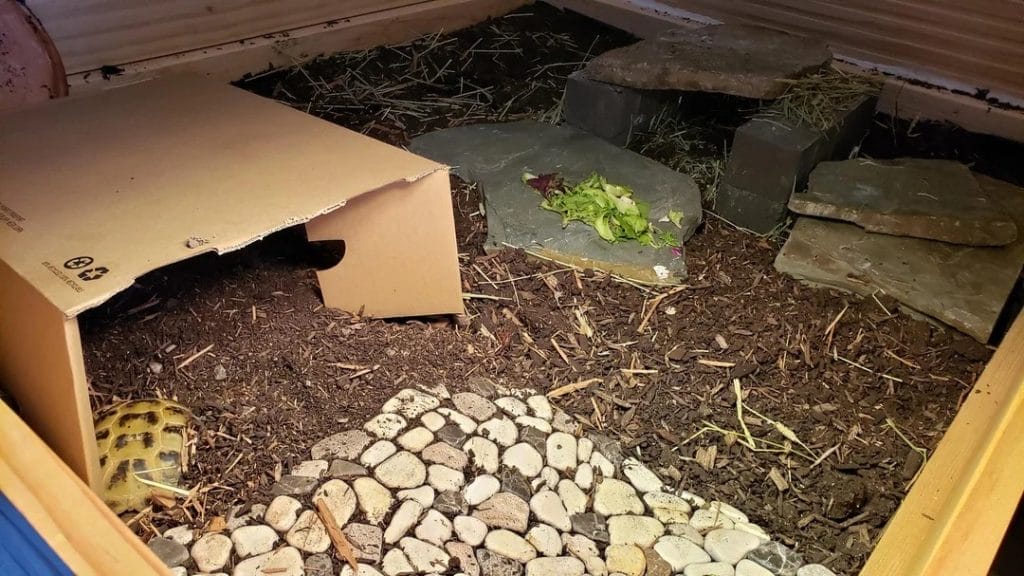The Ultimate Guide to Feeding Red-Eared Sliders: Greens, Proteins, and Secret Tips!

This post was created with help from AI tools and carefully reviewed by a human (Muntaseer Rahman). For more on how we use AI on this site, check out our Editorial Policy.
When I first got my red-eared slider, I had no idea what to feed it—lettuce and a few pellets seemed like enough, right? Well, I quickly learned that their diet is much more complex.
If you want to keep your turtle thriving, the right balance of greens, proteins, and a few key nutrients is critical. Let’s dive into everything you need to know to keep your little swimmer happy and healthy!

what to feed red eared sliders?
Feeding a red-eared slider (RES) can seem complicated at first, but it’s all about balance. I’ll break down everything you need to know about greens, proteins, and a few secret tips to keep your turtle happy and healthy.
Greens
Once your RES becomes an adult, it leans more towards a plant-based diet. My red-eared slider, Spike, absolutely loves his greens. Here’s what I’ve found works best:
- Romaine lettuce: Spike devours it, and it keeps him hydrated.
- Kale: It’s packed with calcium and vitamins, perfect for shell health.
- Collard greens: These are easy on their digestive system and full of nutrients.
- Dandelion greens: They’re super high in calcium and fiber, and Spike can’t get enough.
- Mustard greens: Another healthy option that adds variety.
Just a heads-up—stay away from iceberg lettuce. It’s mostly water and won’t give your turtle the nutrients they need. Always wash greens well to remove any harmful chemicals.

Proteins
Turtles need protein, especially when they’re younger. I remember feeding Spike way more protein when he was a baby than I do now. These are some great options:
- Commercial turtle pellets: These are the backbone of their protein intake. It’s like a multivitamin for turtles.
- Live food: Mealworms, crickets, or earthworms can be offered occasionally. Spike used to go crazy over these when he was smaller.
- Cooked chicken or fish: Small bites of chicken or fish make for a nice treat, but don’t overdo it.
As your turtle gets older, you’ll want to ease off the protein to avoid shell problems like pyramiding. That’s something you definitely don’t want to deal with.
Secret Tips
Here are some tips that helped me keep Spike healthy:
- Variety is Key: Mixing up different greens and proteins keeps your turtle from getting bored and ensures they get a range of nutrients.
- Supplements: I sprinkle calcium powder on Spike’s food a few times a week. It’s a lifesaver if your turtle isn’t getting enough from its diet.
- Feeding Schedule: Younger turtles need to eat every day, but once they’re adults, every other day is fine. Just keep an eye on their weight and energy levels to adjust accordingly.
- Hydration: Always make sure they have fresh water. Spike drinks a lot, and it’s key to digestion.
- Observation: Watch for any changes in their behavior or eating habits. When Spike didn’t eat for a couple of days, I knew something was off. A quick vet visit solved the problem!

Red-Eared Slider Feeding Schedule
Feeding your red-eared slider on a consistent schedule is important for their health. Here’s a simple plan based on their age:
Hatchlings (0-1 year)
- Feed every day: Hatchlings need more protein to grow, so give them commercial turtle pellets daily. You can offer live food (mealworms, crickets) a couple of times a week.
- Greens: Start introducing greens early, but the focus is still on proteins at this stage. Offer greens daily, but they might nibble more than devour.
Baby red-eared sliders have specific needs—our baby turtle feeding guide covers critical first-year nutrition.
Juveniles (1-3 years)
- Feed every day or every other day: You can alternate between greens and proteins. Keep using turtle pellets as the main protein source, but increase the variety of greens (romaine, kale, dandelion greens).
- Live food: Can be offered once or twice a week as a treat.
Adults (3+ years)
- Feed every other day: Adults need more greens than protein. You can offer leafy greens like romaine lettuce, kale, and collard greens on feeding days.
- Protein: Keep turtle pellets as a small portion of the diet, about 25% of what you offer. Occasional live food or treats like cooked fish/chicken can be given once a week.
| Age | Day | Food |
|---|---|---|
| Hatchlings | Daily | Turtle pellets + greens (small amounts) |
| 2x/week | Live food (mealworms, crickets, etc.) | |
| Juveniles | Monday | Turtle pellets + romaine lettuce |
| (1-3 years) | Tuesday | Greens (kale, dandelion, etc.) |
| Wednesday | Turtle pellets + collard greens | |
| Thursday | Greens + live food (mealworms) | |
| Friday | Turtle pellets + kale | |
| Saturday | Greens (mustard greens, romaine) | |
| Sunday | Greens + small protein treat (optional) | |
| Adults | Monday | Romaine lettuce + kale |
| (3+ years) | Wednesday | Turtle pellets + collard greens |
| Friday | Dandelion greens + mustard greens | |
| Sunday | Turtle pellets + a few mealworms (or treat) |
This Hilarious Turtle Book Might Know Your Pet Better Than You Do
Let’s be real—most turtle care guides feel like reading a textbook written by a sleep-deprived zookeeper.
This one’s not that.
Told from the snarky point of view of a grumpy, judgmental turtle, 21 Turtle Truths You’ll Never Read in a Care Guide is packed with sarcasm, sass, and surprisingly useful insights.
And hey—you don’t have to commit to the whole thing just yet.
Grab 2 free truths from the ebook and get a taste of what your turtle really thinks about your setup, your food choices, and that weird plastic palm tree.
It’s funny, it’s honest, and if you’ve ever owned a turtle who glares at you like you’re the problem—you’ll feel seen.
Pet Turtle Diet & Feeding Chart

For a printable version of this amazing diet chart, click here!
Does Red Eared Sliders Need Nutritional Supplements?
Yes, red-eared sliders often benefit from nutritional supplements, especially when it comes to calcium and vitamin D3. Here’s why:
Calcium
Calcium is crucial for your turtle’s shell and bone health. Even with a good diet, they may not always get enough calcium from their food alone. Adding calcium powder to their food a couple of times a week is a great way to prevent deficiencies.
Shell health depends on proper calcium—read our detailed guide on how to provide calcium to turtles.
Vitamin D3
Turtles need vitamin D3 to absorb calcium properly. If your red-eared slider has access to natural sunlight or UVB lighting, they’ll produce their own D3. However, if their UVB exposure is limited, a supplement that includes D3 is important.
When to Use Supplements
- Calcium powder: Sprinkle it on food 2-3 times a week.
- Multivitamins: Some owners use a reptile-specific multivitamin once a week. This ensures they’re getting a balanced mix of nutrients.
By adding these supplements to their diet, you’ll help prevent issues like soft-shell syndrome and other health problems!

Red Eared Slider Turtle Safe Food List
Here’s a table of safe foods for your red-eared slider, broken down into categories:
| Category | Safe Foods |
|---|---|
| Leafy Greens | Romaine lettuce, Kale, Collard greens, Dandelion greens, Mustard greens, Turnip greens |
| Vegetables | Carrots (shredded), Bell peppers, Zucchini, Squash, Cucumber, Green beans |
| Fruits (Occasional treats) | Apples (no seeds), Blueberries, Strawberries, Melon, Banana, Mango |
| Proteins | Commercial turtle pellets, Crickets, Mealworms, Earthworms, Bloodworms, Cooked chicken (small amounts), Cooked fish (small amounts) |
| Aquatic Plants | Duckweed, Water lettuce, Water hyacinth, Anacharis |
| Calcium Sources | Cuttlebone (for gnawing), Calcium powder (sprinkled on food) |
Remember to offer fruits sparingly, as they are high in sugar. The majority of their diet should come from leafy greens and proteins, especially for younger turtles.
Overfeeding is the most common RES mistake—learn how often to feed your turtle to prevent obesity.
Foods Red-eared Sliders Can’t Eat list
Here’s a table of foods that red-eared sliders should not eat:
| Category | Unsafe Foods |
|---|---|
| Leafy Greens | Spinach (binds calcium), Beet greens (high oxalates) |
| Vegetables | Onions, Garlic, Rhubarb, Potatoes |
| Fruits | Citrus fruits (e.g., oranges, lemons), Avocado (toxic) |
| Proteins | Raw meat (risk of bacteria), Processed meats (e.g., ham, bacon), Dairy products (e.g., cheese, milk) |
| Human Foods | Bread, Pasta, Sugary foods, Salty foods, Junk food |
| Plants | Ivy, Azalea, Poison ivy, Any houseplants (unless verified safe) |
Avoid these foods, as they can cause digestive issues, toxicity, or nutrient imbalances. Stick to safe, turtle-friendly options!

Should you offer feeder fish to red eared sliders?
Yes, you can offer feeder fish to red-eared sliders, but it’s best to do so in moderation. Feeder fish, like guppies or minnows, can provide enrichment and a source of protein, especially for young or juvenile turtles. However, there are some important things to keep in mind:
Benefits:
- Protein source: Feeder fish are a natural food choice, providing a healthy source of protein.
- Enrichment: Hunting live fish can stimulate your turtle mentally and physically.
Cautions:
- Risk of parasites: Feeder fish from pet stores may carry parasites or diseases. Quarantining them or buying from a trusted source can reduce this risk.
- Nutritional Concerns: Some common feeder fish like goldfish and rosy red minnows contain an enzyme called thiaminase, which can break down Vitamin B1 (thiamine) in your turtle. To avoid a thiamine deficiency, it’s best to offer these fish only sparingly or to use other types of feeder fish that are thiaminase-free.
- Balance: Too much protein, especially in adult turtles, can lead to health issues like pyramiding (a shell deformity). Keep feeder fish as an occasional treat, not a staple.
A few feeder fish once in a while can be a good addition to their diet, but always focus on a balanced variety of greens and other proteins.

Why isn’t my red eared slider eating?
If your red-eared slider isn’t eating, there could be several reasons behind it. Here are the common problems and their solutions.
1. Incorrect Water Temperature
Turtles are cold-blooded and rely on their environment to regulate body temperature. If the water is too cold, your turtle may become lethargic and lose its appetite.
Solution: Ensure the water temperature is between 75-80°F (24-27°C) for juveniles and 72-75°F (22-24°C) for adults. Use an aquarium heater to maintain this temperature.
2. Lack of UVB Lighting
UVB light is essential for turtles to metabolize calcium and stay healthy. Without enough UVB exposure, they can become weak and lose interest in food.
Solution: Provide a UVB light bulb designed for reptiles and make sure it’s on for 10-12 hours a day. Replace the bulb every 6-12 months as it can lose effectiveness.
The longevity of UVB bulbs can vary by brand and type. Always refer to the manufacturer’s instructions for the specific replacement schedule for your bulb (typically every 6-12 months for fluorescents and up to a year or more for mercury vapor bulbs).
3. Stress or New Environment
If you recently moved your turtle to a new tank or changed their environment, they might be stressed. Stress can cause them to stop eating temporarily.
Solution: Give your turtle time to adjust to the new environment. Ensure their tank has hiding spots and that they feel safe.
4. Illness
Turtles may stop eating due to illness, such as respiratory infections, parasites, or shell problems.
Solution: If your turtle is showing additional symptoms like wheezing, swimming lopsided, or lethargy, it’s best to visit a reptile vet for a checkup.
5. Boredom with Food
Sometimes, turtles stop eating because they’re tired of the same food.
Solution: Offer a variety of foods like leafy greens (kale, romaine lettuce), turtle pellets, and occasional protein treats like mealworms or cooked fish to spark their interest again.
6. Seasonal Changes (Brumation)
Turtles can enter a state of brumation (similar to hibernation) when the temperature drops or during winter months. They may eat less or stop eating altogether.
Solution: A healthy, well-cared-for pet red-eared slider does not need to brumate. If you notice a change in appetite during colder months, first check your tank’s temperature and lighting.
Brumation can be a risky process for pet turtles and should only be undertaken under the strict guidance of an experienced reptile veterinarian.
By checking these common issues and adjusting their environment or care, you should be able to help your turtle regain its appetite!

What do red-eared sliders eat in the wild?
In the wild, red-eared sliders have a varied diet that changes as they age. Here’s a breakdown of what they typically eat:
Hatchlings and Juveniles
Young red-eared sliders are more carnivorous because they need extra protein for growth. Their wild diet includes:
- Insects: Dragonfly larvae, beetles, and other small bugs.
- Small fish: Minnows and other tiny fish.
- Aquatic invertebrates: Snails, worms, and small crustaceans.
- Carrion: They may scavenge dead fish or other animals.
Adults
As they grow, adult red-eared sliders become more herbivorous, eating more plant matter, but they still consume some protein. Their diet includes:
- Aquatic plants: Duckweed, water hyacinth, and algae.
- Leafy vegetation: Floating plants and grasses.
- Small animals: Occasionally, fish, amphibians, and insects.
- Fruits and seeds: If available near the water.
Wild red-eared sliders eat whatever is available in their environment, balancing between plants and proteins based on their nutritional needs.
How Many Pellets To Feed Red-eared Slider?
When feeding red-eared sliders pellets, a good rule of thumb is to offer an amount of pellets that would fit inside their head if it were hollow. Here’s a breakdown:
For Hatchlings and Juveniles (up to 1-3 years)
- Daily feeding: Offer enough pellets to fit in the size of their head once a day. This is about a small pinch, depending on the pellet size.
For Adults (3+ years)
- Every other day: Feed the same “head-sized” amount of pellets, but only every other day. Since adult turtles need more greens, pellets should make up about 25% of their diet.
Always complement pellets with leafy greens and occasional protein treats! Avoid overfeeding as it can lead to obesity and other health issues.

About Author
Muntaseer Rahman started keeping pet turtles back in 2013. He also owns the largest Turtle & Tortoise Facebook community in Bangladesh. These days he is mostly active on Facebook.











